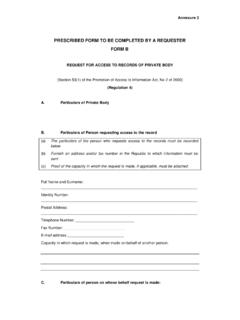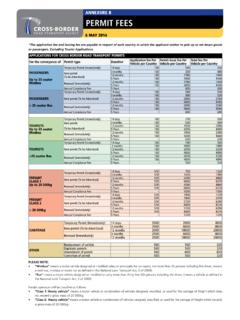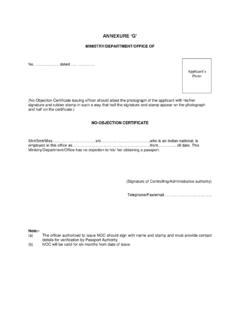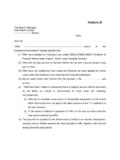Transcription of Compensation data - National Treasury
1 59 B Compensation data The Compensation of public employees is a core determinant of government spending. This annexure presents budget data and trends in Compensation spending. It also examines data from government s payroll system (PERSAL) to gauge trends in public-service employment. A fuller data set is available at Headcount data has been extracted from the PERSAL system. Two points should be noted: The data has been adjusted to reflect the average number of full-time equivalent1 employees over a year. As a result, there may be minor differences between the data published here and information contained in the 2017 Estimates of National Expenditure, which provided a snapshot of unadjusted headcounts at year end.
2 About 240 000 employees on government s payroll are contracted through initiatives such as the Community Work Programme and the Expanded Public Works Programme. Since they are not part of the public service, they are not included in the information presented in this annexure . Unless otherwise indicated, the data is presented in real terms: rand values have been adjusted for inflation and reflect 2016 equivalents. Trends in Compensation spending Compensation spending has grown more quickly than the overall budget over the past eight years, and accounted for per cent of consolidated expenditure in 2016/17, up from per cent in 2008/09.
3 Only interest payments grew faster than Compensation , and the combination of these two factors has resulted in much slower growth in capital, goods and services, and transfer payments. Since 2008/09, nominal GDP has grown at an annual average of per cent a year. Over the same period, spending on public-service Compensation has grown at per cent. 1 An employee who receives fewer than 12 salary payments per year for example, because they are temporary or contract staff is not counted as one full-time employee. Their contributions are aggregated into full-time equivalents.
4 Table Summary of consolidated public expenditure2008/09 2016/17R millionCompensation of employees233 345 510 328 946 472 938 and services117 809 208 098 payments58 627 153 607 707 93 564 489 1 445 719 : National Treasury (budget data )Average annual growth% of total spending in 2016/17 Outcome2017 MEDIUM TERM BUDGET POLICY STATEMENT 60 Figure Growth in nominal GDP and Compensation spending Source: National Treasury (budget data ) Between 2008/09 and 2016/17, Compensation spending increased by about 37 per cent in real terms, or per cent a year.
5 About a quarter of the increase resulted from expanded employment, with the remaining three-quarters due to higher remuneration. In South Africa s constrained fiscal environment, rising Compensation budgets increasingly crowd out other expenditure, including the complementary inputs required for public servants to execute their functions effectively. In labour-intensive National departments such as defence, justice and the police Compensation absorbs a rising share of budget allocations. In provinces, Compensation pressures are particularly high in the health sector. In Limpopo, for example, Compensation accounts for 71 per cent of the health budget, up from per cent in 2008/09.
6 04812162009/102010/112011/122012/132013/ 142014/152015/162016/17 Percentage change (y-o-y)Nominal GDPN ominal Compensation expenditureTable Compensation spending as a share of total expenditure2008/092016/17 Department/Sector % of Total % of TotalNational labour intensive health Cape State West Cape Cape consolidated : National Treasury (budget data ) annexure B: Compensation data 61 Public-service employment trends Between 2001/02 and 2011/12, public-service employment grew rapidly. Employment in public health increased from 216 000 to 318 000. Employment in criminal justice including police, correctional services and justice grew to 261 000 from 181 000.
7 Employment in public education increased from 419 000 to 494 000. The rate of expansion slowed after 2011/12. Measured by full-time equivalents, personnel numbers peaked at million in 2012/13 and have fallen by about 22 000 since then. In health, education and criminal justice, employment levels have declined marginally in recent years. This decline reflects the implicit trade-off between headcount and salaries. While the number of employees stagnated, real remuneration per employee continued to rise after 2011/12, driving up overall spending on Compensation . Figure Total public-service employment(full-time equivalents) Figure Compensation spending, average remuneration and headcount trends Source: National Treasury (PERSAL data ) There are considerable variations within the aggregate trends.
8 As a result, the data should be interpreted with care. Reaching accurate conclusions about the composition of employment in a given sector requires detailed attention to its specific dynamics. For example, while the total number of South African Police Service (SAPS) employees rose from just over 170 000 in 2008/09 to 190 000 in 2016/17, much of this increase resulted from recruitment of civilian employees. This might be viewed as crowding out frontline staff with administrative employees. But civilian personnel cost the SAPS less to perform tasks that would otherwise occupy the time of uniformed officers, freeing the latter to fight crime.
9 The number of police officers has remained broadly stable at about 150 000. Table shows trends in employment and remuneration in the largest occupation-specific dispensation (OSD) groups in the public service. Employment of teachers has not increased since 2009/10, but the nursing provision has continued to grow. On average, remuneration of these two groups has outpaced inflation by more than 2 percentage points over the past seven years. 2017 MEDIUM TERM BUDGET POLICY STATEMENT 62 Table disaggregates the changes in employment by salary level for all employees on the payroll.
10 Although there has been significant headcount growth at managerial levels (salary levels 13-16), the greatest share of growth has been in the ranks of those receiving OSDs. These are generally skilled professionals rather than managers. Absolute declines in employment at the lowest salary levels largely reflect progression and promotion of employees to higher levels, as discussed below. Remuneration trends Employee salaries have increased by an average of 29 per cent since 2008/09. Average remuneration per employee has grown from about R260 000 a year (in 2016 rands) in 2008/09 to R335 000 a year in 2016/17.


















